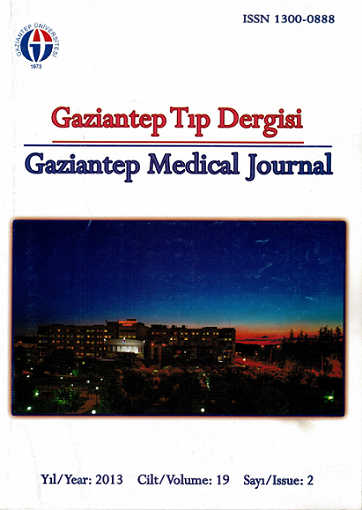The comparison of the effectiveness of the ultrasound and peripheral nerve stimulating techniques during interscalen block
İnterskalen brakiyal pleksus blok uygulamalarında ultrason ve sinir stimülatörü tekniklerinin etkinliklerinin karşılaştırılması
DOI:
https://doi.org/10.5455/GMJ-30-2012-122Keywords:
Analgesic requirement, duration of blockade, interscalen blockade, peripheral nevre stimulator, ultrasoundAbstract
There are potential advantages and disadvantages during ultrasonographic and peripheral nerve stimulating techniques in interscalen plexus blockade. In this study, we aimed to compare the sensory and motor blockade onset time and the duration of postoperative analgesic requirement during interscalen blockade performed with ultrasound and peripheral nerve stimulating techniques. Sixty patients in ASA (American Society of Anesthesiologysts) 1-2 groups were accepted in this prospective and double blind study for the shoulder surgery. Twenty-five ml 0.5% Levobupivacaine was administered to each patient group. The sensory blockade was evaluated with Pinprick test and the motor blockade was evaluated with the Bromage Scale. The duration of the sensorial and the motor blockade and the duration of postoperative first analgesic requirement were noted. The demographic data were similar between the groups. The onset time of sensorial and the motor blockades in group U was significantly shorter than in group S and the first analgesic requirement time in group U was significantly longer than in group S. During the interscalen blockade performed with ultrasound and peripheral nerve stimulator, it was observed that the sensorial and motor blockade was developed faster and the duration of first analgesic requirement was longer with ultrasound technique. Furthermore, it was determined that postoperative patient comfort score was more satisfied by ultrasound technique.
Metrics
References
la Grange P, Foster PA, Pretorius LK. Application of the Doppler ultrasound bloodflow detector in supraclavicular brachial plexus block. Br J Anaesth 1978;50(9):965-67.
Abramowitz HB, Cohen C. Use of Doppler for difficult axillary block. Anesthesiology 1981;55(5):603.
Kestembaum AD, Steuer M, Marano M. Doppler-guided axillary block in a burn patient. Anesthesiology 1990;73(3):586-7.
Vaghadia H, Jenkins LC. Use of a Doppler ultrasound stethoscope for intercostal nerve block. Can J Anaesth 1988;35(1):86-9.
Kirvela O, Svedström E, Lundbom N. Ultrasonic guidance of lumbar sympathetic and celiac plexus block: a new technique. Reg Anesth 1992;17(1):43-6.
Güzeldemir ME, Üstünöz B. Ultrasonographic guidance in placing a catheter for continuous axillary brachial plexus block. Anesth Analg 1995;81(4):882-3.
Daneli G, Fanelli A, Ghisi D, Moschini E, Rossi M, Ortu A, et al. Ultrasound vs nerve stimulation multiple injection technique for posterior popliteal sciatic nerve block. Anesthesia 2009;64(6):638-42.
Perlas A, Brull R, Chan VW, McCartney CJ, Nuica A, Abbas S. Ultrasound guidance improves the success of sciatic nerve block at the popliteal fossa. Reg Anesth Pain Med 2008;33(3):259-65.
Gray AT. Ultrasound-guided regional anesthesia: current state of the art. Anesthesiology 2006;104(2):368–373.
Marhofer P, Chan VW. Ultrasound-guided regional anesthesia: current concepts and future trends. Anesth Analg 2007;104(5):1265-9.
Marhofer P, Frickey N. Ultrasonographic guidance in pediatric regional anesthesia. Part 1: theoretical background. Paediatr Anaesth 2006;16(10):1008-18.
Roberts S. Ultrasonographic guidance in pediatric regional anesthesia. Part 2: techniques. Paediatr Anaesth 2006;16(11):1112-24.
Jan van Geffen G, Tielens L, Gielen M. Ultrasound-guided interscalene brachial plexus block in a child with femur fibula ulna syndrome. Paediatr Anaesth 2006;16(3):330-2.
Winnie AP. Interscalene brachial plexus block. Anesth Analg 1970;49(3):455-66.
Bromage PR. A comparison of the hydrochloride and carbon dioxide salts of lidocaine and prilocaine in epidural analgesia. Acta Anesthesiol Scand Suppl.1965;16:55–69.
Dworkin RH, Turk DC, Farrar JT, Haythornthwaite JA, Jensen MP, Katz NP, et al. Core outcome measures for chronic pain clinical trials: IMMPACT recommendations. Pain 2005;113(1-2):9–19.
Davis JJ, Swenson JD, Greis PE, Burks RT, Tashjian RZ. Interscalene block for postoperative analgesia using only ultrasound guidance: the outcome in 200 patients. J Clin Anesth 2009;21(4):272–7.
Martinoli C, Bianchi S, Santacroce E, Pugliese F, Graif M, Derchi LE. Brachial plexus sonography: a technique for assessing the root level. AJR Am J Roentgenol 2002;179(3):699–702.
Perlas A, Chan VW, Simons M. Brachial plexus examination and localization using ultrasound and electrical stimulation: a vounteer study. Anesthesiology 2005;99(2):429–35.
Chan VW. Applying ultrasound imaging to interscalene brachial plexus block. Reg Anesth Pain Med 2003;28(4):340–3.
Royse CE, Sha S, Soeding PF, Royse AG. Anatomical study of the brachial plexus using surface ultrasound. Anaesth Intensive Care 2006;34(2):203–10.
Riazi S, Carmichael N, Awad I, Holtby RM, McCartney CJ. Effect of local anaesthetic volume (20 vs 5ml) on the efficacy and respiratory consequences of uktrasound-guided interscalene brachial plexus block. Br J Anaesth 2008;101(4):549–56.
Brull R, McCartney CJ, Chan VW, El-Beheiry H. Neurological complications after regional anesthesia: contemporary estimates of risk. Anesth Analg 2007;104(4):965–74.
Barrington MJ, Watts SA, Gledhill SR, Thomas RD, Said SA, Snyder GL, et al. Preliminary results of the Australasian Regional Anaesthesia Collaboration: a prospective audit of more than 7000 peripheral nerve and plexus blocks for neurologic and other complications. Reg Anesth Pain Med 2009;34(6):534–41.
Orebaugh SL, Williams BA, Vallejo M, Kentor ML. Adverse outcomes associated with stimulator-based peripheral nerve blocks with versus without ultrasound visualization. Reg Anesth Pain Med 2009;34(3):251–5.
Urmey WF, Gloeggler PJ. Pulmonary function changes during interscalene brachial plexus block: effects of decreasing local anesthetic injection volume. Reg Anesth 1993;18(4):244–9.
Bigeleisen PE. Anatomical variations of the phrenic nerve and its clinical implication for supraclavicular block. Br J Anaesth 2003;91(6):916–7.
Plit ML, Chhajed PN, Macdonald P, Cole IE, Harrison GA. Bilateral vocal cord palsy following interscalene brachial plexus nerve block. Anaesth Intensive Care 2002;30(4):499–501.
Hoşten T, Gürkan Y, Solak M, Toker K. A case of Horner’s syndrome following lateral sagittal infraclavikular blok. Agri 2008;20(4):45-8.
Downloads
Published
How to Cite
Issue
Section
License
Copyright (c) 2023 European Journal of Therapeutics

This work is licensed under a Creative Commons Attribution-NonCommercial 4.0 International License.
The content of this journal is licensed under a Creative Commons Attribution-NonCommercial 4.0 International License.


















